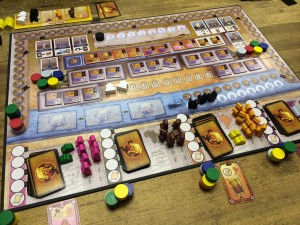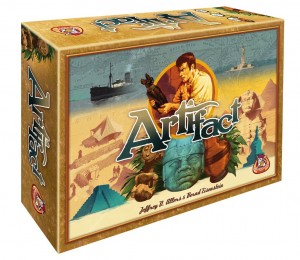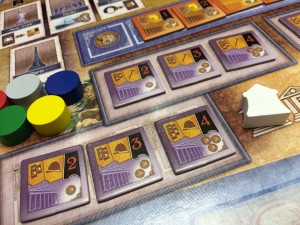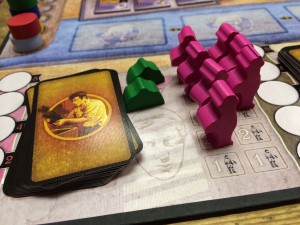Review: Artifact
Posted by James (admin) on February 7th, 2014
 Artifact is a worker placement game with a difference as players place a common set of action markers which are limited in number and the cost of using them varies.
Artifact is a worker placement game with a difference as players place a common set of action markers which are limited in number and the cost of using them varies.
THE GAME
Players are archaeologists digging up artifacts, shipping them home and putting on exhibitions (after all, as Indy taught us, ‘they belong in a museum’). Players primarily score victory points (VPs) at game end by gaining museum exhibition tiles and having cash. The final round is triggered by one of 4 different events such as finishing the 8th round, when one deck of artifact cards runs out, etc.
Actions
During a round, players take turns performing either 1 or 2 actions. If a player passes, they can not perform any more normal actions that round (although they can perform a special action on their turn). All players start each round with 6 wooden action markers and there are 6 different types of these: ships, museums and 4 different colours of workers (one for each continent). The board has a track for each type of action marker and each space on these tracks shows a cost (going from from 5 down 1).
When a player performs an action, they (a) place one of their action markers onto the most expensive empty space of the relevant track, i.e. museum markers onto the museum track, (b) pay the cost shown on the track space where they placed their action marker, and then (c) perform an action based on the type of action marker placed. As a result, performing actions at the start of a round is usually more expensive than later on when other players have placed action markers back on the tracks which cover up the more expensive spaces. Therefore, you need to balance taking an expensive action early in a round with taking it later when it’s cheaper but risking someone already doing what you wanted to do.
Players use a museum action marker to place one of their expedition tents on a continent where they have no tents, and use a worker action marker to place an expedition tent on a continent where they already have tents. If a tent is not the only one on a continent, placing a tent adds an artifact card (from the relevant continent’s deck) to that continent. However, what a player discovers is not theirs yet.

A player using a ship action marker can remove all of their tents from a continent and take one revealed artifact card for each of their tents removed (placing them in their hand). Ship action markers can also be used to sell an artifact card from your hand to the black market for up to 7 cash (or buy artifact cards that have been sold to the black market).
Museum action markers can also be used to claim exhibition tiles. If the player can discard a relevant set of artifact cards (from their hand) , they can take the tile, i.e. 3 artifacts with pick-axe icons, 4 artifacts from Africa, etc. The tiles are worth VPs but they also generate extra income each round too.
At the start of each round, players gain income based on the remaining museum tiles in one particular row. As tiles get removed, income goes down, so the pressure is on to gain exhibition tiles to maintain (and hopefully increase) your income each round.
A player can use any action marker to perform any action by paying 6 cash instead of the normal cost to place it. This can be especially useful but can also be incredibly expensive.
Passing
A player who passes can not perform any more actions but they can take one of the action markers from the board for their next turn (or swap one of their remaining markers). This can make actions more expensive for players who have not yet passed (plus gives them a good selection of markers to choose from). The last player to pass becomes the next turn’s first player and, in turn order, players take action markers to bring their total up to 6, i.e. each player fills up to 6 before the next player does so.
Expansions
A couple of optional expansions are built into the game board. These add a few more mechanics and make things more interesting. As well as some special artifact cards, the first expansion tracks the number of times players start a new expedition on each continent and score VPs based on the continent where they went the least. The second expansion allows player to choose an on-going special ability after they put on an exhibition, such as draw an extra card when you ship artifacts, earn 3 more cash when selling to the black market, etc.
THOUGHTS
 Artifact definitely offers lots of elements to balance, plus you need to watch out for what other players are doing too. You need the right mix of action markers to perform the actions you want to and that suit your situation. For example, having worker markers for a continent are not very useful if you don’t already have a tent there and don’t have a museum to start an expedition there.
Artifact definitely offers lots of elements to balance, plus you need to watch out for what other players are doing too. You need the right mix of action markers to perform the actions you want to and that suit your situation. For example, having worker markers for a continent are not very useful if you don’t already have a tent there and don’t have a museum to start an expedition there.
It’s good to perform 1 action per turn so your actions are likely to be cheaper later (because others will have taken actions), but you want to use 2 actions per turn so you can do your actions before your opponents screw you by doing them first. Taking 2 actions is incredibly tempting, especially to place a worker to add an artifact card to a continent and then ship artifacts right from under the next player’s nose (mwa-ha-ha).
You also need cash, and lots of it. Like in life, cash won’t guarantee happiness but it does give you options. High scoring exhibitions usually give you little extra income; so the high income (lower VP) museum tiles have their advantages. To put on exhibition requires artifacts and that means placing expedition tents and shipping – so you can see that Artifact has plenty to think about and the number of actions you get each round never feel like enough (in a good, tense way).
Having one fewer card than there are tents on each continent is quite an evil game mechanic as it means there’s always someone who will not get as many artifacts as tents placed. This adds extra tension to when deciding which action you should take before other players beat you to it.
The expansions are very good and I would use them every time and experienced gamers may find it too plain without them as they add extra game mechanics and decisions.
I think the board looks very good and the iconography is excellent and explanatory. The worker pieces for each continent have a strange shape making them top heavy which is a bit annoying as they fall over all the time (and I’m still trying to work out what the ship silhouette is). Also, I’d prefer the cash track around the board to have numbers on every space rather than just on the multiples of 5 as it just makes it quicker to move pieces, especially if there are quite a few players covering up the numbers that are there. These physical/visual element issues are very minor though.
I have played the game with 3 and 5 players and I have to admit I prefer it with fewer players. With more players, there’s a lot more that can happen between your turns so it’s harder to plan (although at least there are more continents for the players to be spread across). Artifact definitely requires a plan too, especially as you’re committing to your mix of actions next round actions before it has even started. I like this tension but it can be unforgiving, especially if you don’t have cash to let you use any of your markers for any action.

Two green expedition tents are on this continent and lots of workers for this continent are available.
There is one game mechanic that I’m not keen on and that’s the turn order system. The player who is last to pass becomes first player – this is okay but the rest of turn order simply goes clockwise from the first player. This meant I felt I had no real control over my turn order – if I wasn’t the last to pass (and that’s hard to engineer without cash or the correct action markers) then my turn order was decided by whoever did. Turn order is slightly balanced going first is often more expensive; however, it’s the way the action markers are taken that can make turn order an issue for me.
Going last in the turn means you bring your total of action markers up to 6 after everyone else does and this can result in there being none of the type you want/need which can completely break your next round. (I was second to last to pass in a round but ended up last in turn order and there were no ship markers left to take. I could have paid 6 cash to use any action marker as a ship but it would have meant I couldn’t afford any other action and would have passed after 1 action.) Not having enough expedition markers isn’t as bad – it’s the more versatile/central museum and ship markers that are in high demand and mess you up most if you don’t have them. The issue is made slightly worse with more players because the average number of action markers per player is lower. If players just refilled their markers one at a time in turn order, then this wouldn’t be anyway near as much of an issue.
FINALLY
Whilst I’m not a fan of the turn order system, I really enjoyed Artifact as I really liked the choices and decisions it presented me with. There’s lots to balance in terms of timing as well as logistics. It can be an unforgiving game but you can avoid this by remembering that cash is vital – little cash means few actions which means little progress usually meaning little income. In the future, I would prefer to play it with 3 or maybe with 4 players (not with 5) because my preference is for a slightly more controllable plan.
James.
[Played with 3 and 5 players]

